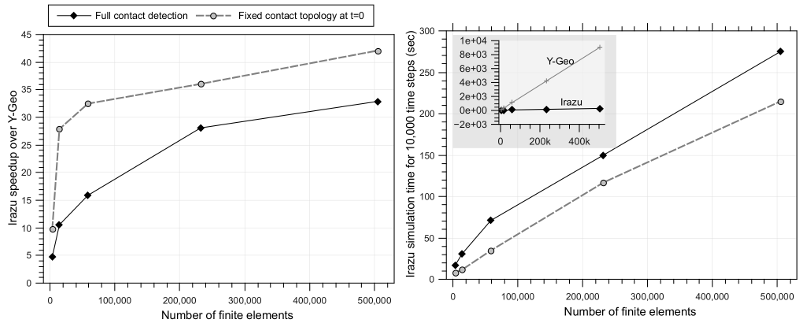Irazu makes use of state-of-the-art high performance computing techniques to speed-up computations. In particular, we use GPU (graphics processing unit) computing on consumer-grade AMD graphics cards. To demonstrate the improvement in computation speed, five uniaxial compression strength (UCS) tests with an increasing number of finite elements were simulated using Irazu and the sequential CPU code Y-Geo. The number of elements, nominal element size, and time step size are summarized in the table below. Each of these models was executed for 10,000 time steps and the elapsed time between the first and last output (i.e., time step = 0 and time step = 10,000) were compared. All simulations were performed on a standard desktop computer equipped with an Intel Core i7 CPU @ 3.4 GHz (over clocked to 4.0 GHz), 16 GB of RAM, and AMD Radeon R9 200 series GPU with 3 GB of on-board memory.
| Number of finite elements | Element size (mm) | Time step size (ms) |
|---|---|---|
| 3,630 | 2.00 | 10-5 |
| 14,600 | 1.00 | 10-6 |
| 58,524 | 0.50 | 10-7 |
| 232,128 | 0.25 | 10-8 |
| 504,756 | 0.10 | 10-9 |
The relative speed-up of Irazu over Y-Geo, defined by the ratio of Y-Geo simulation time divided by Irazu simulation time, is presented in the figure below (left). Full contact detection refers to an Irazu simulation where contact detection is performed at each time step. In contrast, fixed contact topology at t=0 refers to a simulation where contact detection is only performed once at the beginning of the simulation. The latter approach is only suitable for models with small displacements, where new contacts among elements are not formed during the simulation (for instance, hydraulic fracturing applications). As the figure below shows, Irazu exhibited a substantial speed-up over Y-Geo, starting at around 5 times for the smallest model, but increasing to 30 times for the largest model. The speed-up for models with fixed topology was even greater, peaking at over 42 times for the largest model. This trend shows that a greater GPU performance boost is realized when more elements and, thus, more parallel working groups are employed.
As depicted in the right figure, Irazu showed a linear increase in simulation time as a function of the number of elements (R2=0.99). Although the simulation time in Y-Geo is also linearly proportional to the number of elements (see inset of right figure), the slope of the line defining simulation time versus number of elements is significantly lower for Irazu (approximately 36 times), indicating the computational efficiency is far superior. Overall, the results show that GPU-powered computations in Irazu lead to an impressive reduction in simulation time compared to the sequential Y-Geo CPU code.
This text is part of our paper for the ARMA rock mechanics symposium in Houston, Texas, June 26-29, 2016. You can download the full paper here ![]() .
.
